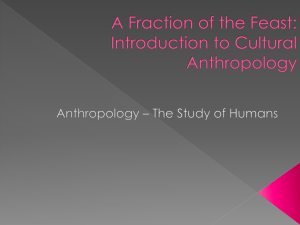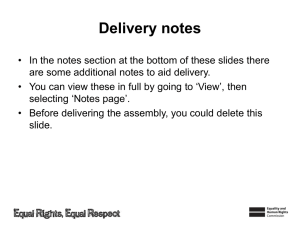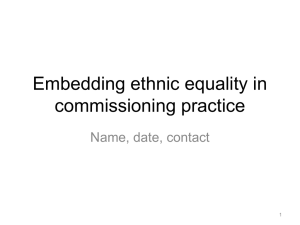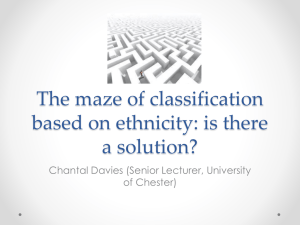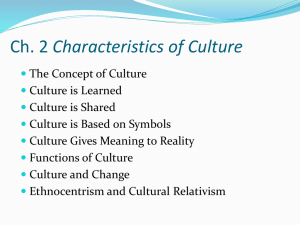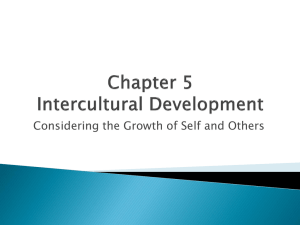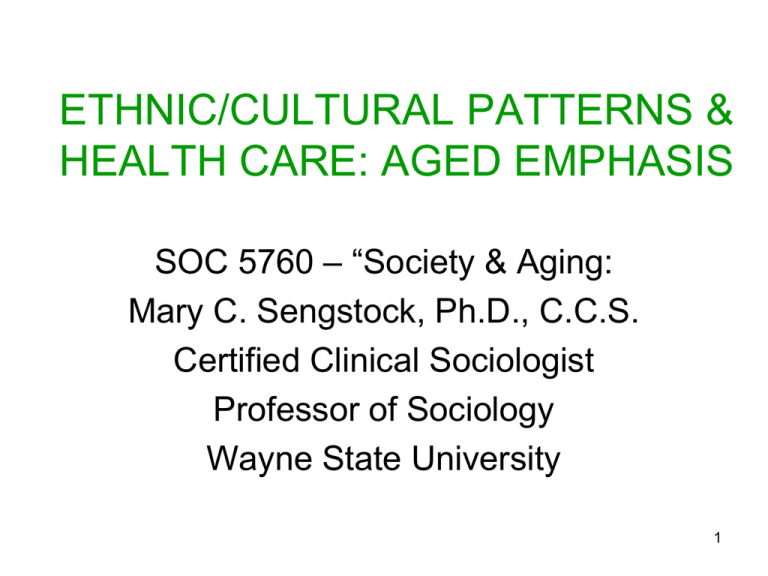
ETHNIC/CULTURAL PATTERNS &
HEALTH CARE: AGED EMPHASIS
SOC 5760 – “Society & Aging:
Mary C. Sengstock, Ph.D., C.C.S.
Certified Clinical Sociologist
Professor of Sociology
Wayne State University
1
OBJECTIVES
• Analyze Major Ethnic/Cultural
Patterns in 21st Century U.S.
• Analyze the Impact These Patterns
May Have Upon Health Care
• Suggest Ways Health Care
Professionals May Deal with these
Patterns in Health Care Settings
2
ETHNICITY: 21ST CENTURY U.S.
• U.S. History of Immigration
• Cultural Differences Based on Numerous
Factors:
– Race
– Religion
– Nationality, Language
• 1968 Federal Laws Increased Rate of
Immigration
3
DETROIT AREA ETHNICITY
•
•
•
•
•
•
Race
Foreign Born
Home Language Other Than English
Nationality Identification
2000 Census
2006 Estimates
4
TRI COUNTY ETHNICITY 2000
• Total Population:
•
•
•
•
•
4,043,467
Foreign Born:
325,994 ( 8.1%)
Foreign Language:
438,582 (10.8%)
Black:
1,002,038 (24.8%)
Asian:
101,386 ( 2.5%)
Total Non-White:
1,103,424 (27.3%)
5
MAJOR NATIONALITY GROUPS
•
•
•
•
•
•
•
•
German:
641,304
Polish:
440,914
Irish:
410,930
Italian:
265,214
French:
163,500
Hispanic:
118,641
Arabic:
19,185
Iraqi (+Chaldean): 10,104
(15.9%)
(10.9%)
(10.2%)
( 6.6%)
( 4.0%)
( 2.9%)
( 0.5%)
( 0.2%)
6
CHANGES 2000 to 2006
2000
Population 4,043,467
For. Born 325,994 (8.1%)
For. Lang. 438,582 (10.8%)
Black
Asian
2006
4,018,500
367,013 ( 9.1%)
480,695 (12.0%)
1,002,038 (24.8%) 1,014,715 (25.2%)
101,386 (2.5%)
141,363 (3.5%)
7
DEMOGRAPHIC SUMMARY
•
•
•
•
•
•
Area Population Decreasing Slightly
Minority Population Increasing
Black Population Increasing
Asian Population Increasing
Middle Eastern Population Increasing
Sizeable Foreign Born/Language
Population
• Continued Importance of Ethnic Identity
8
ETHNIC IDENTITY – RELEVANCE
• Racial Groups (Blacks, Asians) Have
Different Health Problems, Patterns
• Language Differences Affect
Understanding of Health Requirements
• Nationality Groups Have Persistent
Differences in Personality Traits, Religious
Beliefs, Which Can Affect Health
Perceptions
9
CAUTIONS
• Focus of Lecture Is NOT to Summarize All
Ethnic Groups & Their Practices – Too Many!
• No Single Pattern Fits Any Given Ethnic Group
– Whites Include Many Nationalities
– Hispanics Include Central & South Americans
– Blacks Include Descendants of Slaves, Immigrants
from Africa & Caribbean
• Cannot Assume Any Individual Fits the Pattern
• So Many Cases No Lecture Can Include All!
10
2 DIMENSIONS OF ETHNICITY
AND AGING
• Minority Aging: How Do Minorities
Experience Aging Differently Than
Dominant Middle Class Whites?
• Ethnic Aging: How Do Ethnic Differences
Impact on the Way Aging Is Experienced –
and How Can Professionals Help?
11
MINORITY AGING – SUMMARY
• TRIPLE JEOPARDY:
– OLD
– POOR
– MINORITY RACE/ETHNICITY
• ALL THE DISADVANTAGES OF EACH!
12
MINORITY AGING – OVERALL
•
•
•
•
•
•
Fewer Aged: More Births; Short Life Expectancy
Lower Incomes (Pre & Post Retirement)
Health Is Poorer
Usually More Urban
Usually Higher Status Within Ethnic Community
Usually More Family And Community Support &
Responsibility For Aged
• Highly Resilient Aged – Probably Because They
Are “Survivors”
13
ETHNIC AGING:
3 IMPORTANT ISSUES
• 1. HEALTH PROBLEMS OF GROUP
• 2. CULTURAL DIFFERENCES
- Usually Affect Immigrants and Their
Children
• 3. SOCIAL DIFFERENCES
- Can Persist for Several Generations
14
HEALTH PROBLEMS:
AFRICAN-AMERICANS
• 2X As Many Chronic Diseases as Whites
• Higher Incidence Than White Elders of:
– Hypertension
Heart Disease
– Cancer
Diabetes
Depression
– Obesity
Kidney Failure
– Decline in Functional Ability
– Diabetes 2X As High Among Black Women
– Breast Cancer Particularly Virulent
15
HEALTH PROBLEMS:
HISPANICS
• Great Diversity Among Groups (Cubans
Healthier Than Mexican or Puerto Rican)
• Immigrant Hispanics Have BETTER
Health Than the American-Born!
• Smoking A Particular Immigrant Problem
• Diet & Cultural Patterns Change in U.S.
• Smoking, Alcohol & Drug Use Increases
• Breast Feeding & Fiber Consumption Decline
16
HEALTH PROBLEMS:
ASIAN-PACIFIC ISLANDERS
• Great Variability Among Various Groups:
– Japanese & Chinese Elders Healthier Than
U.S. Population in General (Healthier Diet?)
– Japanese: Higher Rate of Digestive Cancers,
Suicide
– Native Hawaiians: Higher Mortality Due to
Heart Disease & All Causes of Death
– General: Higher Rates of Hypertension,
Cholesterol, Osteoporosis, Cancer
– Particularly Among Low Income Groups
17
HEALTH PROBLEMS:
NATIVE AMERICANS
• Poorest Health of All Americans
• Higher Incidence Than White Elders of:
– Diabetes
Hypertension
Accidents
– Tuberculosis
Heart Disease Strokes
– Liver & Kidney Disease
Pneumonia
– Influenza
Hearing & Visual Impairments
– Gallbladder
Arthritis
– Problems Related to Obesity
18
CULTURAL DIFFERENCES
•
•
•
•
•
LANGUAGE
MYTHS
BELIEFS
ORIENTATION TOWARD WORLD
PROPER DEMEANOR
19
LANGUAGE DIFFERENCES
• People With First Language Not English
– Most Immigrants
– Some Second Generation
• Speakers of “Non-Standard” English
– African-Americans – “Black English”
– Appalachian Whites
20
FOREIGN LANGUAGE –
CONSEQUENCES
• Misunderstand Instructions
– Even When They Know English
– EX: 24 Hr Urine Specimen
– “Partitioned Language” (Israeli Colleague)
• Translation Necessary – Problems:
– Arabic Mother-in-law As Translator
– Child as Translator
– Café Au Lait Vs. Café Au Lit
21
GERIATRIC IMPLICATIONS
• 2nd Language Speakers
– May “Forget” 2nd Language When Old or Sick
• 2 Types of Foreign-Born Elderly:
– Immigrant Elderly (Worked – Became
Acculturated)
– “Invited” Elderly (Came Retired; Not
Acculturated – Less Likely to Know English)
22
MYTHS
• What Cures or Prevents Disease:
– Laos: Hair Prevents Disease (Drs.
Shave for Surgery, Treatments)
• Folk Medicine
– Dependence on Folk Medicine First
(Delay Doctor Visits)
– Hispanics: The Group Helps You Heal
(Medicine Separates You)
23
BELIEFS
• Southern Blacks:
– Polio Shot = Flu Shot = Blood Test
• Mexicans:
– Blood Sample = Blood Donor
• Understanding of Medicines:
– All Heart Medicines Are the Same
24
GERIATRIC IMPLICATIONS
• Chinese: Bad Omens – EX:
– Do Not Discuss Illness or Death With Aged
• Japanese: Dementia Seen as Shameful
– Reluctant to Acknowledge Mental Disease
– High Rate of Suicide
• Mexicans: Many Folk Beliefs – EX:
– No Cure for Heart Disease – Death Sentence
25
ORIENTATION TO WORLD
• Present Vs. Future Orientation
• Fatalism:
– Arabs, Irish: Treatment Defies God’s Will
– Hispanics: Stoicism
– Evil Eye (Many Peasant Cultures – Even
Religious People Believe It)
• Reaction To Pain
– Italians, Arabs: Yell, Avoid Anesthetic
– Irish: Suffer In Silence
26
PROPER DEMEANOR
• Close Physical Contact In Conversation
vs. Respectful Distance
• Appropriateness Of Eye Contact
• Preference for Direct vs. Indirect
Conversation
• Formal vs. Informal Agreements
– Distrust Consent Forms (esp. Women)
• Reluctance to Accept Youth & Women in
Formal Statuses
27
GERIATRIC IMPLICATIONS
• Prefer Informal Care:
– Home Care Is Expected
– Exceptions (Japanese for Mental Problems)
• Formality in Care:
– Prefer Formal Means of Address (Polish)
– Differential Address for Staff v. Patients
– Polish Discomfort with Informal Visits
• Irish Preference for Independence
28
CONSEQUENCES FOR
PHYSICIANS, NURSES
• Makes It Difficult to Interpret Level of Pain or
Need for Treatment
• Need to Consider Possible Ethnic Traditions
• Not Easy to Determine Patient’s or Family’s
Ethnic Background
• Language Use or Names May Not Indicate
Ethnic Background or Traditions!
– Name Changes Due to Marriage or Immigration
29
SUMMARY OF CULTURAL
DIFFERENCES
• These Include Cultural Ethnic Patterns:
– Beliefs, Myths, Omens
– Attitudes: Fatalism, Orientation to Present
– Demeanor: Formal, Informal, Independent
• Cultural Patterns Tend to Disappear Once
Initial Generation Is Acculturated or Dies
• 2nd Generation Becomes More Used to
Urban, Industrial Society Environment
30
SUMMARY OF
SOCIAL DIFFERENCES
• Differences in Social Patterns (vs Culture)
• These Differences Can Persist For
Several Generations! (Long After
Individual Identifies as “Ethnic”!)
• This is Because They Are NOT Seen as
“Ethnic” …
• But Rather as “Normal Human Behavior”
31
SOCIAL DIFFERENCES
• Family Structure:
– Family Statuses; Roles for Women; Roles for
Children
• Social Practices Based on Beliefs About
the Family and Society:
– Living Arrangements; Inter-Relations Between
Generations; Child-Rearing Practices; Visiting
Practices; Beliefs About Privacy; Acceptance
of Professional “Helpers”
32
FAMILY STRUCTURE
• Family Statuses:
– Who is Head of Family?
– Who Can Instruct a Man?
– Who Can Instruct an Older Person?
– Nature of Husband – Wife Relations
– Who Decides Whose Health Care?
33
FAMILY STRUCTURE (ctd)
• Roles for Women:
– Can Women Make Own Decisions?
• Roles for Children:
– Do Children and Adults Interact Much?
– Can Children Serve as Adult’s
Interpreter or Instructor?
– Will They Have the Information to Be
Effective? (EX: Vietnamese Sex Taboo)
34
SOCIAL PRACTICES
Based On Beliefs Re Family
• Family Living Patterns:
– Inter-Generational Households
– Close Neighbors
– Functionally Extended Households
• Inter-Relation Between Generations:
– Italians: Adults Not in Children’s Activities
35
SOCIAL PRACTICES
Based On Beliefs Re Family
• Child-Rearing Practices:
– Who Is Child’s Caregiver: Mother?
– Or Grandmother?
• Visiting Practices:
– Irish (& Arabs): Long, Casual Visits (& Loud!)
– Polish: Short, Announced Visits
(Patient “Receives”)
– Blacks Need/Want Privacy
36
SOCIAL PRACTICES
Based On Beliefs Re Family
• Acceptance of Professional “Helpers”
– Many Groups Resist Professional Helpers –
Especially with Psychological Services
– Irish: Good at Deflecting Information
Requests
• Nature of Family Support:
– Jewish: Social Support Is Critical – Not Acts
– Polish: Acts Important – Not Feeling
37
GERIATRIC IMPLICATIONS
• Most Prefer Family Care of Elderly
(Chinese, Japanese, Arabs, Chaldeans,
Polish, Italians, Others)
• Elderly Depression if Family Not Close
(Arab/Chaldean Study)
• May Produce Great Family Stress
(“Sandwich Generation”)
• Must Respect Status of Elders
38
WHAT TO MAKE OF ALL THIS?
• How to Keep Track of All These Different
Types of People?
• How to Find Out Who Is Who & Who
Follows Which Pattern?
• No Easy Answers – No Clear Outline of
Ethnic Differences
• Sensitivity to the Needs of Patients Is
Critical
39
WHAT CAN DOCTORS DO?
• Watch For Signs of Non-Compliance –
Inquire Why
• Do Not Assume a Family Translator Will
Be Honest or Effective
• Use Paid Translators If Possible
• Try to Match Patient and Interviewer
– Age, Gender, Race or Ethnicity
40
WHAT CAN DOCTORS DO? (ctd)
• Watch for Indications the Patient or Family
Is Uncomfortable With Someone
• Do Not Assume Family Members Can or
Will be Acceptable/Effective Caregivers
• Do Not Assume Non-Family Caregivers
Will Be Acceptable/Effective
41
RESPECT TRADITIONS
• Try Not to Force Patients to Accept Unfamiliar
Patterns
• Respect Patients’ Desire for Formal Titles
• Accommodate Food & Social Patterns Where
Possible
• Accommodate Needs of Family Members to
Accompany Patient
• Recognize the Role of Social & Cultural Patterns
in Recovery
42
MEDICAL PROFESSIONALS’
COMPENSATION
•
•
•
•
•
•
A More Satisfied Patient & Family
A Patient More Likely to Respond Well
Patients More Likely to Return
Patients Willing to Refer Others
Good Will for Practice & Hospital
Feeling Physician Has Done a Good Job
43

